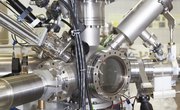
A spectrometer analyzes light absorbed by a sample, then uses that information like a chemical fingerprint to identify what molecules are in the sample. Spectrometers are used to monitor pollution, identify medical problems and optimize material fabrication. Traditional spectrometers do this by sending one wavelength at a time through a sample. Fourier transform infrared (FTIR) spectrometers do the same job much more quickly by sending many wavelengths of light through the sample simultaneously. To do accurate, quantitative measurements, a spectrometer needs to be calibrated.
- FTIR spectrometer
- Calibration standards
Subtract the background. Every instrument has its own measurement characteristics that change with time, temperature, and ambient environment. Take a measurement with nothing in the sample compartment and store that as the background. The spectrometer will automatically subtract the background from subsequent measurements.
Use the internal calibration source. Many FTIR spectrometers have an internal fixed-spectrum source used for internal calibrations. The internal calibration routine will automatically determine any corrections and apply them to the detector output.
Insert a calibration standard into the sample compartment and acquire a measurement. The calibration standard is a known compound with a known concentration. Ideally, your calibration standard will have spectral features in the same region as your unknown. Consult the National Institute of Standards and Technology for information as well as the actual gas, liquid, or solid standard reference materials (SRMs).
Repeat the previous step with samples of different concentrations. You will want to cover the range of possible concentrations of your sample.
Do a regression analysis to develop an equation representing the detector response as a function of calibration standard concentration. For example, your measurements will show something like this: your detector measures 70 counts at a certain wave number when the concentration is 100 parts per million (ppm), 40 counts at 200 ppm, and 10 counts at 300 ppm. A regression analysis would show that the number of counts is 100 - 0.3 * concentration in ppm. In practice, this will all be done by the same software package you use to analyze your data.
Things You'll Need
References
About the Author
First published in 1998, Richard Gaughan has contributed to publications such as "Photonics Spectra," "The Scientist" and other magazines. He is the author of "Accidental Genius: The World's Greatest By-Chance Discoveries." Gaughan holds a Bachelor of Science in physics from the University of Chicago.
Photo Credits
Jupiterimages/Comstock/Getty Images
